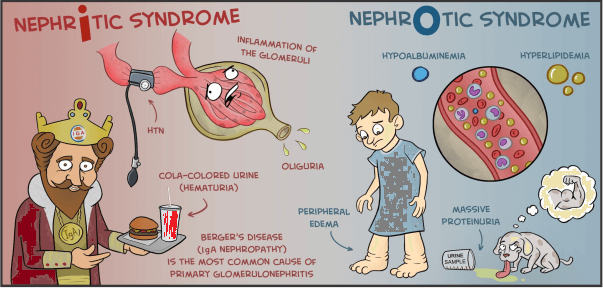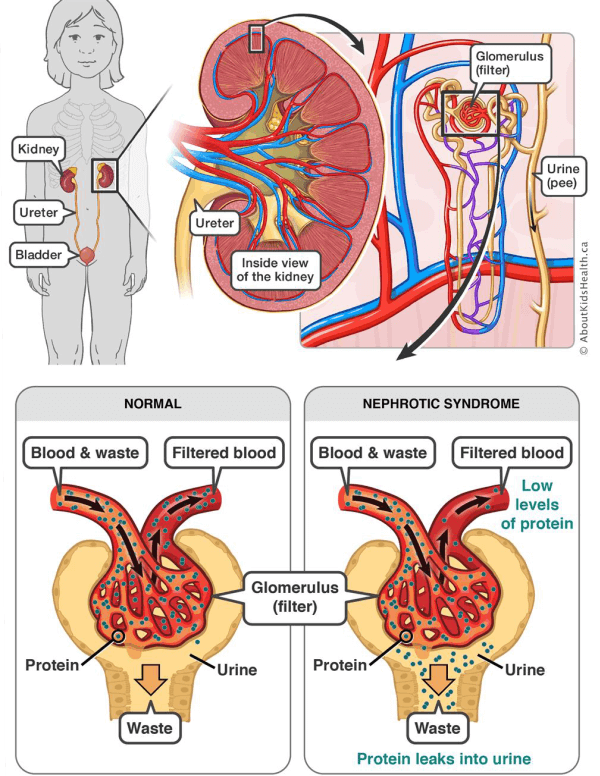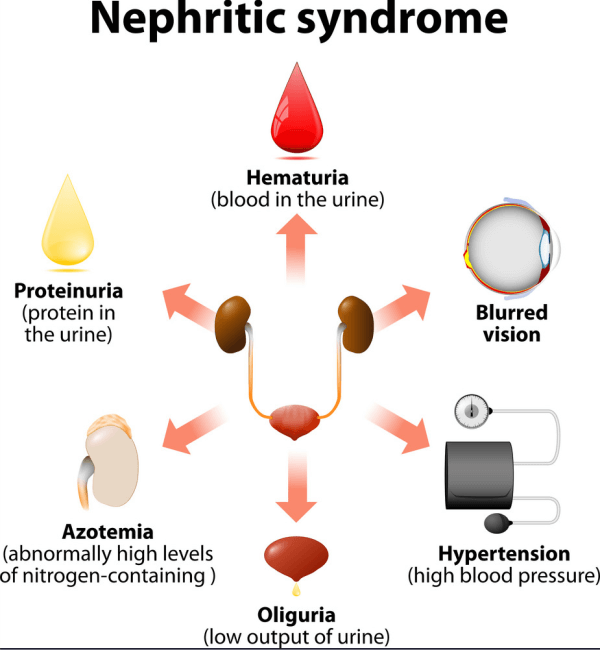Difference between Nephrotic and Nephritic SyndromeThe kidneys are vital organs that help filter waste products and excess fluid from the body. Nephrotic and nephritic syndromes are two types of kidney disorders that can lead to problems with this process. They are two distinct renal diseases that affect the kidney's filtering system. While both conditions affect the kidneys, they have different underlying causes, symptoms, and treatments. These conditions can cause a range of symptoms, including swelling, hypertension, and proteinuria. While both syndromes are characterized by abnormal kidney function, they differ in their underlying causes and treatment options. 
What is Nephrotic Syndrome?Nephrotic syndrome is a medical condition that affects the kidneys and causes the body to excrete too much protein in the urine. The condition can have various underlying causes and can lead to serious complications if left untreated. However, there are many examples of nephrotic syndrome that demonstrate its diagnosis, treatment, and progression of the condition. The glomeruli, which are tiny blood arteries that remove waste and extra fluid from the circulation, are the target focus of the nephrotic. It is characterized by the presence of high levels of protein in the urine, low levels of protein in the blood, swelling, and high levels of cholesterol in the blood. While the nephrotic syndrome is a serious condition that requires treatment, it has several uses in medicine and research. 
Uses of Nephrotic Syndrome
One of the primary uses of nephrotic syndrome is as a diagnostic tool. Doctors can use the presence of certain symptoms and laboratory values associated with the condition to help diagnose other underlying health issues. For example, a patient with nephrotic syndrome may be a sign of a more serious underlying condition such as diabetes, lupus, or kidney disease.
Nephrotic syndrome is also used as a research tool to study the structure and function of the kidneys. By studying the disease process and mechanisms behind nephrotic syndrome, researchers can better understand how the kidneys work and how they may be affected by other diseases or conditions.
Nephrotic syndrome is caused by immune system dysfunction and is often treated with immunosuppressive therapy. These same therapies are also used to treat other immune system disorders, such as lupus, rheumatoid arthritis, and psoriasis. Studying nephrotic syndrome can help researchers develop better treatment options for these other immune disorders.
Nephrotic syndrome is a complex condition that can be difficult to treat, but studying the disease can lead to the development of new therapies. Researchers can use animal models to test potential therapies and determine whether they may be effective in treating human patients. This can lead to the development of new drugs, therapies, or procedures that can improve the lives of patients with nephrotic syndrome.
Proteinuria is a condition in which high levels of protein are present in the urine, which is a common symptom of nephrotic syndrome. By studying nephrotic syndrome, researchers can better understand the causes and mechanisms behind proteinuria. This can lead to the development of better diagnostic tools and treatments for proteinuria, which is a common symptom of many different types of kidney disease.
Biomarkers are substances that can be measured to indicate the presence or severity of a disease. Studying nephrotic syndrome can help researchers identify new biomarkers that can be used to diagnose and monitor the disease. These biomarkers can also be used to develop new therapies and track the progress of patients undergoing treatment.
Nephrotic syndrome is a glomerular disease, which means that it affects the tiny blood vessels in the kidneys. Researchers can better understand other glomerular diseases, such as IgA nephropathy, membranous nephropathy, and focal segmental glomerulosclerosis, by studying nephrotic syndrome. This improved understanding can lead to better diagnostic tools and treatment options for these other glomerular diseases.
Genetic mutations can cause nephrotic syndrome, and studying the disease can help identify these genetic markers. This can lead to better diagnostic tools and genetic testing for patients with nephrotic syndrome and their family members who may be at risk for the condition. What is Nephritic Syndrome?Nephritic syndrome is a kidney disorder that is characterized by inflammation of the glomeruli, which are tiny filters in the kidneys that remove excess fluid, waste, and toxins from the blood. This condition can lead to impaired kidney function, which can cause various symptoms and complications. 
Causes of Nephritic SyndromeNephritic syndrome can be caused by a variety of factors, including infections, autoimmune disorders, and genetic mutations. The most common cause of nephritic syndrome is an infection, such as streptococcal infection, which can cause a type of nephritic syndrome known as post-streptococcal glomerulonephritis. Other causes of nephritic syndrome include IgA nephropathy, membranoproliferative glomerulonephritis, and lupus nephritis. Genetic mutations such as Alport syndrome can also lead to the nephritic syndrome. Symptoms of Nephritic SyndromeDepending on how severe the illness is, nephritic syndrome can present with a variety of symptoms. The most common symptoms of nephritic syndrome include blood in the urine, swelling in the face, hands, and feet, high blood pressure, and decreased urine output. Some other underlying symptoms of the nephritic syndrome are headache, fatigue, vomiting, nausea, and a general feeling of unwellness. Diagnosis of Nephritic SyndromeThe nephritic syndrome can be difficult to diagnose because many of its symptoms are vague and can be linked to other medical disorders. To identify the nephritic syndrome, a doctor will often do a physical examination, examine the patient's medical history, and prescribe a number of tests. These tests may include a urine test to check for the presence of blood and protein, a blood test to check for high levels of creatinine and other waste products in the blood, and a kidney biopsy to examine the kidney tissue for signs of inflammation and damage. Treatment of Nephritic SyndromeThe treatment of nephritic syndrome will depend on the condition's underlying cause. In many cases, the nephritic syndrome will resolve on its own without treatment. However, if the condition is caused by an infection, the use of antibiotics is recommended to help clear it. If the condition is caused by an autoimmune disorder, such as lupus nephritis, immunosuppressant drugs may be prescribed to reduce inflammation and slow the condition's progression. In severe cases of nephritic syndrome, dialysis or kidney transplant may be necessary. Precautions to Avoid Nephritic Syndrome
A healthy lifestyle is essential to maintain good kidney function. This includes eating a healthy diet that is low in sodium and high in fiber, staying hydrated, getting regular exercise, and avoiding smoking and alcohol.
Nephritic syndrome can be caused by infections such as strep throat, which can spread through close contact with an infected person. To avoid contracting such infections, it is essential to practice good hygiene, such as washing hands regularly, covering the mouth when coughing or sneezing, and avoiding contact with people who are sick.
Certain infections, such as strep throat, can be prevented by vaccination. It is important to get vaccinated against such infections to reduce the risk of developing nephritic syndrome.
High blood pressure is a risk factor for nephritic syndrome. Monitoring blood pressure regularly and taking steps to lower it if it is high can help prevent the onset of this condition.
Exposure to toxins, such as heavy metals and certain chemicals, can damage the kidneys and increase the risk of developing nephritic syndrome. Limiting exposure to such toxins by avoiding contact with them or wearing protective gear when working with them can help prevent the onset of this condition.
The risk of developing nephritic syndrome increases significantly if the patient at hand is suffering from obesity. A nutritious diet and regular exercise can help maintain a healthy weight and delay the onset of this illness.
Regular health check-ups can help detect any underlying medical conditions or changes in kidney function early on, allowing for early intervention and prevention of nephritic syndrome. Differences between Nephrotic and Nephritic Syndrome
ConclusionIn conclusion, nephrotic and nephritic syndromes are two distinct clinical conditions that affect the kidneys. While they share some common symptoms, they have distinct differences in their pathophysiology, clinical presentation, and treatment. Nephrotic syndrome is characterized by proteinuria, hypoalbuminemia, edema, and hyperlipidemia and is caused by damage to the glomerular capillary wall. Nephritic syndrome is characterized by hematuria, proteinuria, hypertension, and reduced GFR and is caused by inflammation of the glomerulus. The treatment of both syndromes depends on the underlying cause, and the prognosis varies depending on the severity of the disease and the response to treatment.
Next TopicDifference between
|
 For Videos Join Our Youtube Channel: Join Now
For Videos Join Our Youtube Channel: Join Now
Feedback
- Send your Feedback to [email protected]
Help Others, Please Share










